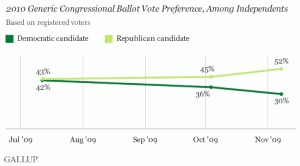I spent perhaps a bit too much time this morning trying to put the spreadsheet below into graphical form:
| Pollster | Time | R | D | R +/- |
| NPR | Oct 3/4 | 43 | 43 | 0 |
| NPR | Sept 4/4 | 45 | 48 | -3 |
| Politico | Oct 4/4 | 46 | 45 | 1 |
| Politico | Oct 3/4 | 46 | 46 | 0 |
| Politico | Oct 2/4 | 44 | 46 | -2 |
| Politico | Oct 1/4 | 45 | 46 | -1 |
| Politico | Sept 4/4 | 44 | 46 | -2 |
| Politico | Sept 3/4 | 45 | 47 | -2 |
| Rasmussen | Oct 4/4 | 46 | 43 | 3 |
| Rasmussen | Oct 3/4 | 44 | 43 | 1 |
| Rasmussen | Oct 2/4 | 42 | 43 | -1 |
| Rasmussen | Oct 1/4 | 43 | 44 | -1 |
| Rasmussen | Sept 4/4 | 45 | 41 | 4 |
| Rasmussen | Sept 3/4 | 44 | 43 | 1 |
| Rasmussen | Sept 2/4 | 44 | 43 | 1 |
| Rasmussen | Sept 1/4 | 42 | 44 | -2 |
It shows the current pollsters checking the Generic Congressional Ballot, as per RCP. Most of the labels are self-explanatory: “R +/-” represents the amount by which Republicans are ahead/behind on any given poll. RCP’s current average is R+1.3, which represents a strong shift towards the Republicans in the last month among all three pollsters: 5 points for Rasmussen, 4 points for Politico, and 3 for NPR (although ‘shift’ is possibly the wrong word for the last one, given that there’s only been two polls).
Continue reading 2012 shaping up like 2004, on the Generic Congressional Ballot level.

